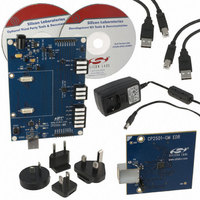CP2501DK Silicon Laboratories Inc, CP2501DK Datasheet - Page 4

CP2501DK
Manufacturer Part Number
CP2501DK
Description
KIT DEVELOPMENT CP2501
Manufacturer
Silicon Laboratories Inc
Datasheets
1.CP2501DK.pdf
(14 pages)
2.CP2501DK.pdf
(2 pages)
3.CP2501DK.pdf
(2 pages)
4.CP2501DK.pdf
(30 pages)
5.CP2501DK.pdf
(1 pages)
6.CP2501DK.pdf
(2 pages)
Specifications of CP2501DK
Main Purpose
Interface, Touch Screen Controller
Embedded
Yes, MCU, 8-Bit
Utilized Ic / Part
CP2501
Primary Attributes
USB Configurable Parameters such as VID, PID and Strings
Secondary Attributes
GPIO, I²:C; SMBus, SPI, UART Interface
Interface Type
USB, I2C, SPI, UART
Operating Voltage
3.3 V
Data Bus Width
16 bit
Maximum Operating Temperature
+ 85 C
Minimum Operating Temperature
- 40 C
For Use With/related Products
CP2501
Lead Free Status / RoHS Status
Lead free / RoHS Compliant
Other names
336-1988
CP2501-DK
4.2. Silicon Labs IDE
The Silicon Labs IDE integrates a source-code editor, source-level debugger and in-system programmer. The
following sections discuss how to open an example project in the IDE, build the source code, and download it to the
target device.
4.2.1. Running the CP250x_NoScreen example program
The CP250x_NoScreen example program drags a simulated finger starting from the top left corner of the screen
towards the middle of the screen and releases.
4.2.2. Creating a New Project
Use the following steps to create a new project. Once steps 1-5 in this section are complete, continue at Step 4 in
Section 4.2.1.
4
1. Open the Silicon Labs IDE from the Start menu.
2. Select Project
3. Browse to the C:\SiLabs\MCU\Examples\CP250x\NoScreen directory (default) and select the
4. Once the project is open, build the project by clicking on the Build/Make Project button in the toolbar or
5. Before connecting to the target device, several connection options may need to be set. Open the Connec-
6. Click the Connect button in the toolbar or select Debug
7. Download the project to the target by clicking the Download Code button in the toolbar.
8. Click on the Go button (green circle) in the toolbar or by selecting Debug
9. Connect the USB connector on the daughter board to a Windows Vista or Windows 7 PC that supports HID
10. The device will enumerate and then drag the simulated finger across the screen.
1. Select Project
2. Select File
3. Right-click on “New Project” in the Project Window. Select Add files to project. Select files in the file
4. For each of the files in the Project Window that you want assembled, compiled and linked into the target
5. Save the project when finished with the debug session to preserve the current target build configuration,
CP250x_NoScreen.wsp project file and click Open.
selecting Project
Note: After the project has been built the first time, the Build/Make Project command will only build the
files that have been changed since the previous build. To rebuild all files and project dependencies, click
on the Rebuild All button in the toolbar or select Project
tion Options window by selecting Options
“USB Debug Adapter” option. Next, the correct “Debug Interface” must be selected. CP2501 devices use
Silicon Labs “C2” 2-wire debug interface. Once all the selections are made, click the OK button to close the
window.
device.
Note: To enable automatic downloading if the program build is successful select Enable automatic con-
nect/download after build in the Project
build process, the IDE will not attempt the download.
ning the firmware.
touchscreens.
ognized extension, such as .c, .h, or .asm, to enable color syntax highlighting.
browser and click Open. Continue adding files until all project files have been added.
build, right-click on the file name and select Add file to build. Each file will be assembled or compiled as
appropriate (based on file extension) and linked into the build of the absolute object file.
Note: If a project contains a large number of files, the “Group” feature of the IDE can be used to organize.
Right-click on “New Project” in the Project Window. Select Add Groups to project. Add pre-defined
groups or add customized groups. Right-click on the group name and choose Add file to group. Select
files to be added. Continue adding files until all project files have been added.
editor settings and the location of all open debug views. To save the project, select Project
As... from the menu. Create a new name for the project and click on Save.
New File to open an editor window. Create your source file(s) and save the file(s) with a rec-
Open Project to open an existing project.
New Project to open a new project and reset all configuration settings to default.
Build/Make Project from the menu.
Target Build Configuration dialog. If errors occur during the
Rev. 0.1
Connection Options... in the IDE menu. First, select the
Connect from the menu to connect to the
Rebuild All from the menu.
Go from the menu to start run-
Save Project










